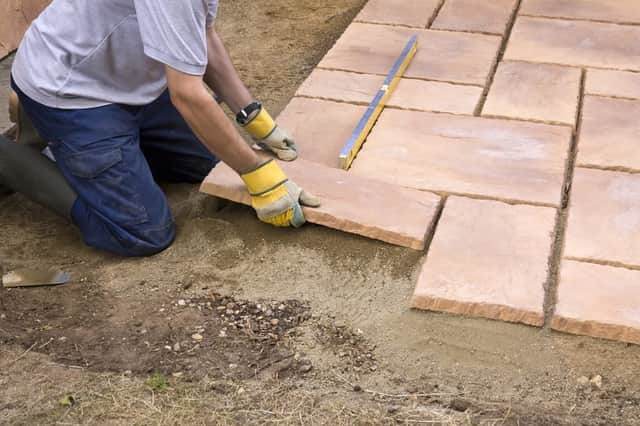9 tips on laying paving slabs in your garden - and what materials you’ll need


Laying a patio is a big undertaking, and the first tip here is probably to get a professional in to do it for you.
While we can’t lay out a full guide on how to install a new patio here, but there are plenty of good ones online though.
Advertisement
Hide AdAdvertisement
Hide AdIf you do still insist of taking on the job yourself, here are 9 handy tips to make the whole thing go just that little bit smoother:
Choose your slabs carefully
You might not think blocks of concrete could be all that varied. But they are.
Different colours, finishes and materials all need to be considered when planning out your patio. Patios aren’t something you can easily alter, and chances are you’ll be looking at the results of your efforts for years to come, so choose wisely.
Do you want one, uniform colour? Or do you want to mix it up a little bit?
Mix it up – even if it’s all the same colour
Advertisement
Hide AdAdvertisement
Hide AdIf you do opt for the former, as you’re laying the patio, mix and match slabs from different pallets if you’re using more than one.
There may be some imperceptibly small colour differences between any two batches, and while you might not notice it as you’re laying it out, two separate sections of slightly differently shaded patio are going to stand out.
Plan plan plan
You’ll need to take into account a whole host of factors when planning out you patio.
More than just thinking about how the whole thing might look when it’s finished, you’ll need to factor in giving your patio a ‘fall’ that runs away from the house or outbuildings, so rainwater can’t accumulate.
Advertisement
Hide AdAdvertisement
Hide AdA fall of 1:60 (16mm per metre) is the generally accepted standard.
You’ll also need to think about the depth at which you’ll lay your patio: 150mm below the damp proof course if directly next to your house, and 10mm below ground level if it’s going to adjoin your lawn (for ease of mowing).
Take a ‘dry run’
You’ll need to be meticulous in your planning when thinking about your patio.
There's no ‘one size fits all’ model, and your patio with have to be tailor designed to your specifications.
Advertisement
Hide AdAdvertisement
Hide AdEven once everything’s all planned out, and the slabs have arrived, you’ll want to lay them out to make sure any mistakes in measurements are rectified; there’s no going back once things start to get fixed down!
This is also a good chance to make sure you’re happy with the arrangement of any different coloured slabs, confirming it’s a pattern you're happy with. Make a visual so you can remember how it all goes.
Wait for dry weather
Doing DIY in the pouring rain is never fun, but it’s especially important you wait for a dry spell before starting to lay your new patio.
You’ll need to wait for dry weather before applying kiln dried sand.
Gather your materials
Advertisement
Hide AdAdvertisement
Hide AdExactly what materials you’ll need for the job will differ depending on what you’ve got planned, but generally speaking, the following will come in handy:
- Paving slabs
- Cement
- Fine, kiln-dried block paving sand - for jointing smaller joints
- Building sand - for jointing larger joints
- Long timber straight edge - for ensuring your sub-base is level
- 2 - 22mm timber or dowel off-cuts - used to make spacers for joints
- Off-cut piece of timber - to protect the slab when laying
Save yourself some turf
If you’re having to remove any turf for your patio, it’s recommended that you save some for later.
That way, you can fill in any gaps between your lawn and the new patio towards the end of the job.
Stay safe
Unlike other, relatively low intensity DIY tasks (moving the lawn, or painting a fence for instance), installing a new patio can be a demanding, physical task.
Advertisement
Hide AdAdvertisement
Hide AdThat’s why you should make sure you’re properly kitted out in any personal safety equipment before you start.
Suitable footwear (steel toe caps recommended) and gloves should be worn when handling slabs, sand, gravel or cement, and dust masks, safety goggles and protective gloves will come in handy when mixing and applying mortar, mixing concrete and applying wet or dry cement.
Don’t be afraid to ask for help
Paving slabs can be surprisingly heavy, and laying a patio often involves carting around other heavy items.
Don’t be a hero, and don’t be afraid to ask someone to help.